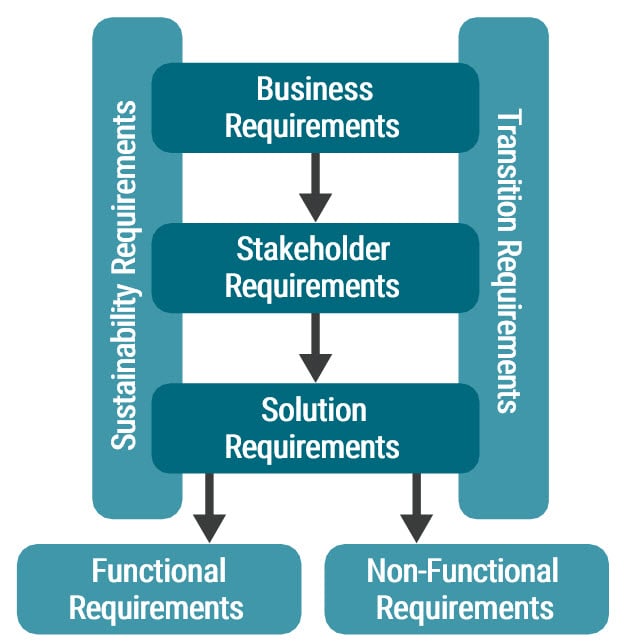
3. Performing Business Analysis
Value to be Delivered
The Business Analysis Standard
Business analysis professionals should help enterprises to create value for their business and stakeholders. Effective business analysis focuses on:
- understanding the enterprise strategy;
- clarifying business problems and opportunities to clearly identify and understand business needs;
- identifying the potential value to be created;
- translating business needs into goals that support the development of high-value solutions;
- discovering, interpreting, and communicating business information;
- understanding and sharing knowledge of the value to be created;
- identifying who:
- the value is being created for;
- can contribute to the creation of value; and
- may be impacted;
- helping stakeholders to stay focused and make decisions about:
- approaches;
- priorities; and
- trade-offs;
- balancing value creation within:
- constraints;
- different opinions;
- risks; and
- complexity.
- clarify business needs with stakeholders;
- define the value to be delivered through solutions; and
- implement the desired change within the context.
The more an individual is proficient in a competency, the more he is able to apply it in the right context—and the more he is able to create the desired value.
Underlying competencies are applied in many contexts and on different types of initiatives, including but not limited to:
- process redesign;
- business architecture;
- technology solutions implementations;
- digital transformation initiatives;
- data warehousing initiatives;
- cyber security initiatives;
- business data analytics;
- product ownership analysis related work.
IIBA Guide to the Business Analysis Body of Knowledge Version 3 (BABOK® Guide v3) describes 29 underlying competencies that support business analysis tasks. IIBA’s Business Analysis Competency Model® v4 describes how competencies can be applied when executing those tasks.
Ongoing stakeholder engagement is necessary for building a shared understanding of the change effort, the value to be created, and the actual work to enable the change. The following five competencies were identified by the global community as important for any type of initiative and should be developed by all business analysis professionals:
Adaptability |
Adjusting behavioural style to increase effectiveness. |
Facilitation |
Facilitating workshops, negotiating, and helping resolve conflicts. |
Leadership and Influencing |
Building consensus, recommending solutions, and guiding stakeholders to the desired value. |
Problem Solving |
Ensuring that created value addresses the root cause of problems. |
Systems Thinking |
Holistically understanding the enterprise and context to maximize the value delivered. |
There are more than 90 business analysis techniques in total, described in the following:
- BABOK® Guide;
- Agile Extension;
- Guide to Business Data Analytics; and
- Guide to Product Ownership Analysis.
Each technique can be beneficial in the right context to help create the desired value. The following techniques were identified by the global community as applicable for many different types of initiatives and are a good starting point for new business analysis professionals:
Backlog Management |
The planned approach to record, track and prioritize the remaining work items. See: Agile Extension to the BABOK Guide v2, 7.1 Backlog Refinement |
Customer Journey Mapping |
Visually defining the end-to-end customer experience, including motivations and experience when they’re interacting with the solution. See: Guide to Product Ownership Analysis, 6.4 Customer Journey Map |
Data Storytelling |
Providing business context or highlighting key insights from data with an engaging narrative drives better business decisions. See: Guide to Business Data Analytics, 3.7 Data Storytelling |
Process Analysis |
Analyzing processes for their efficiency and effectiveness and identifying opportunities for creating greater value. |
Workshops/Interviews |
Collaborating with stakeholders to learn, teach, assess, or review important business information and drive the desired value. See: BABOK Guide v3, 10.50 Workshops, and BABOK Guide v3, 10.25 Interviews |
To ensure the delivery of the expected value by the change initiative, business analysis professionals translate the needs of stakeholders into more detailed requirements and designs.
Working with Requirements and Designs
Requirements and designs can be a document, a set of documents, or various models. The distinction between requirements and designs is not always clear. The same techniques are used to elicit, model, and analyze both.
Requirements |
Designs |
|
|
Requirements leads to designs which, in turn, may drive the discovery and analysis of more requirements. The back-and-forth shift in focus between requirements and designs is often subtle and not always linear.
Requirements may be used to define a design. That design may then be used to elicit additional requirements that can lead to more detailed designs. In some cases, requirements and designs are handed off to others who may further develop these designs.
Example:
Requirements — the need |
Designs — the potential solution |
|
|
|
|
|
|
|
|
|
|
Requirements’ Classification
As mentioned above, a requirement is “a usable representation of a need.” The BABOK® Guide lists four main requirement types – Business, Stakeholder, Solution (including functional and non- functional requirements), and Transition requirements. In addition to these, business analysis can help an enterprise meet its commitment to sustainability.
Business Requirements are:Statements of goals, objectives, and outcomes for why a change has been initiated. They can apply to the whole enterprise, a business area, or a specific initiative. Stakeholder Requirements are:The needs of stakeholders that must be met to achieve the business requirements. They may serve as a bridge between business and solution requirements. Solution Requirements are:The capabilities and qualities of a solution that meet the stakeholder requirements. They provide the detail to allow for the development and implementation of the solution. Solution requirements can be: Functional Requirements: the capabilities a solution must have for the behaviour and information the solution will manage. Non-functional Requirements or Quality of Service Requirements: conditions or qualities a solution must have. See BABOK Guide v3, 10.30 Non-Functional Requirements Analysis |
 |
Sustainability Requirements are:
Assessment and description of goals that connect business, stakeholder, or solution requirements to an enterprise’s sustainability objectives. They describe how a business area or a specific initiative will deliver on those objectives. See Sustainability
Transition Requirements are:
The capabilities and the conditions needed to facilitate a transition from the current to the future state. They are temporary and address areas such as data conversion, training, business continuity, etc.
Tracing Requirements and Designs
Traceability is the ability for tracking the relationships between requirements and designs from the original stakeholder need to the actual implemented solution. Traceability supports change control by ensuring the source of a requirement or design can be identified and other related requirements and designs potentially affected by a change are known. – Glossary
It is difficult to accurately represent needs and solutions without considering their relationships. The traceability of requirements and designs is used to identify and document the lineage of each requirement and design, including its backward traceability to the original business need, its forward traceability to the solution components, and its relationship to other requirements and designs. Traceability can help ensure that the solution conforms to requirements and designs and can assist in scope, impact, change, risk, time, cost, and communication management.
Organizations often trace their requirements and designs using a traceability matrix structure. A traceability matrix enables bi-directional tracking of requirements and designs by linking them to the business need and solution components. Using a traceability matrix helps to detect missing requirements and designs or to identify solution components that are not supported by any requirement or design.





















